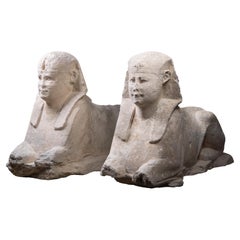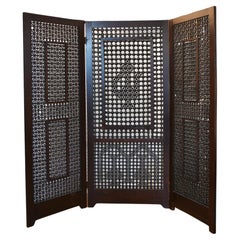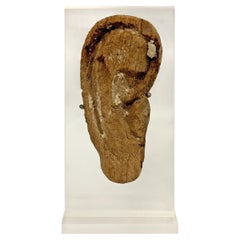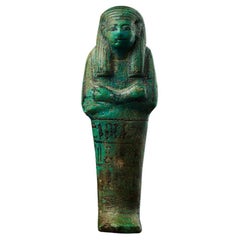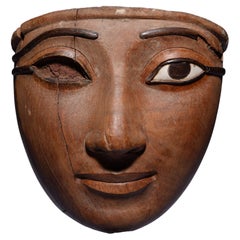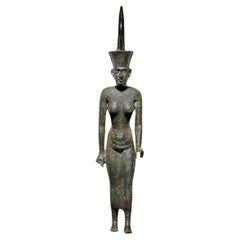North African Furniture
121
to
16
65
50
121
121
121
121
165
3,948
1,651
332
1,797
1,325
31
2
42
78
130
333
160
163
92
93
52
42
34
11
10
6,195
24,720
6,396
6,320
5,404
2
1
1
Period: 18th Century and Earlier
Place of Origin: North African
Ancient Egyptian Monumental Temple Sphinxes
Located in London, GB
A pair of monumental limestone sphinxes of Pharaoh Nectanebo I, from the processional avenue of the Serapeum of Memphis, 30th Dynasty, circa 379 - 360 BC.
The sphinxes of the Serapeum have captivated travellers since Roman times. However, despite their significance, they are conspicuously absent from the collections of most major museums. Indeed, their existence in private hands is so improbable, and their imitations so numerous, that the present sphinxes were assumed to be modern copies throughout their recent ownership history. Finally recognised and conserved after an extraordinary chance discovery at a garden furniture sale...
Category
15th Century and Earlier Egyptian Antique North African Furniture
Materials
Limestone
Middle Eastern Wooden Floor Screen
Located in Brooklyn, NY
Middle Eastern three panel wood floor screen with decor in center in form of censers, central panel circa 18th century. Dimensions: 80.25"H x 91"W. Ask us about our local NYC delivery.
Category
18th Century Islamic Antique North African Furniture
Materials
Wood
Late-Period to Ptolemaic Period Egyptian Wooden Mummy Mask Ear on Custom Mount
Located in Chicago, IL
This Late Period to Ptolemaic Period Egyptian carved wood ear, once part of a mummy mask, stands as a poignant testament to ancient Egyptian customs and beliefs. Dating back over 250...
Category
15th Century and Earlier Egyptian Antique North African Furniture
Materials
Wood
Ushabti for Imenmes
Located in London, GB
A mummiform ushabti in blue faience. Four registers of hieroglyphic characters are painted around the lower half of the ushabti, with a vertical column of hieroglyphs in the centre o...
Category
15th Century and Earlier Egyptian Antique North African Furniture
Materials
Faience
Exceptional Egyptian Sarcophagus Mask
Located in London, GB
Exceptionally Fine Wooden Sarcophagus Mask
Third Intermediate Period, 21st Dynasty, circa 1069-945 BC.
Acacia wood, rosewood, hippopotamus ivory
Masterfully carved from a single piece of fine-grained hardwood, the present mask is characteristic of the most exquisite funerary art made during the 21st Dynasty, and was probably commissioned for a particularly high-ranking individual.
The oval face displays a gently smiling mouth with full, outlined lips, furrows at the corners and a bow-shaped philtrum. The straight nose with rounded nostrils, the cheeks full and fleshy and the large, almond shaped eyes with heavy lids and tapering cosmetic lines, set below long, sweeping eyebrows.
Social collapse across the Mediterranean in the Late Bronze Age meant that the 21st Dynasty in Egypt was a period of great turmoil. Trade routes were disrupted, governments collapsed, and mass migration occurred. Economic scarcity meant that traditional funerary practices in Egypt were also affected, with a lack of material and financial resources leading to the reuse of preexisting material. As a result, during the 21st Dynasty, 19th and 20th Dynasty coffins changed ownership rapidly and were heavily recycled for new purposes. Tombs were also unmarked allowing them to be shared
by many people. These new practices brought forth a shift in the understanding of funerary paraphernalia. No longer important objects owned forever by the deceased, they were now simply seen as short-term transformative devices, whose symbolic and ritualistic meaning could be appropriated for others. However, paradoxically, the art of coffin-making also reached new heights during this period, and many of the richly dec- orated “yellow” coffins, characteristic of the 21st Dynasty, are remarkable works of art in their own right. Indeed, knowing that coffins were being reused throughout Egypt, the Egyptian élite set themself apart by commissioning lavish sarcophagi decorated with the images and texts meant to help guide them to the afterlife, and which would otherwise have adorned the tomb walls. As coffins were the chief funerary element which now identified the dead and allowed them a physical presence in the world of the living, their quality and appearance were of the utmost importance.
The traditional coffin ensemble was made of three parts: a wooden mummy cover, which laid directly atop the mummy, an inner coffin, and an outer coffin, both made of a lid and case. Additional decorative elements, such as masks, were carved out separately and later glued or pegged to the lids. After the completion of the painted decoration, the sarcophagus was covered in a varnish to give it its yellow colour. Gilding was sometimes used for the coffins of the high priests’ families, notably on parts representing naked skin, such as the face mask. However, some of the élite tactically avoided gilding altogether as to ensure that their coffin would not be looted.
When manufacturing the inner and outer coffins, particular attention was paid to the woodwork. Displaying the skill of the carpenter, this type of funerary art has largely remained unparalleled throughout Egyptian history. The principal wood used to craft the present mask is Acacia nilotica. The evergreen Egyptian acacia was considered sacred and said to be the tree of life, the birthplace of the god Horus, as well as symbolic of Osiris, the god of the dead and resurrection. The modelling of the face in the wood is superb, but the inlays also help mark this mask out as exceptional. Inlaid eyes and eyebrows were extremely rare and reserved to the finest and most expensive coffins. Traditionally, eyes were made of calcite, obsidian, or quartz, and eyebrows of coloured glass paste or bronze. Here, the pupils, eyebrows, and cosmetic lines are inlaid with Dalbergia melanoxylon, a rare type of wood which belongs to the rosewood genus.
In antiquity, however, it was known as Ebony of the Pharaohs, from the Egyptian word “hbny”, meaning dark timber, because of its black, lustrous appearance. An extremely dense and hard wood requiring significant skill to work with, ebony was a luxury material highly coveted by the pharaohs themselves, to make furniture, decorative and funerary objects. The wood was imported with great effort from the southern Land of Punt, most likely modern Sudan, Ethiopia, Djibouti, and Eritrea, alongside other luxury goods such as gold and ivory.
A magnificent ebony throne, recovered in the tomb of King Tutankhamun, illustrates the incredible aesthetic potential of this material and why it was so highly valued by Egyptian royalty. Only élite members of Egyptian society could have afford- ed Ebony of the Pharaoh inlays for their funerary mask.
The sclerae on the present piece were once both inlaid with hippopotamus ivory. Whiter than elephant ivory, this type of ivory is also denser, and more difficult to carve. The use of this luxury material, reputed for its gleaming appearance, enhances the lifelikeness of the eyes. For the Egyptians, hippopotamus ivory was imbued with magic powers. The hippopotamus was indeed both feared and venerated due to its aggressive behaviour. Whilst the male hippopotamus was associated with danger and chaos, the female was benevolent and invoked for protection, especially of the house and
of mothers and their children, through the hippopotamus goddess Tawaret. Thus, not only was hippopotamus ivory used as an inlay and to make practical objects, such as combs and clappers, but it was also used to make talismans like apotropaic wands or knives.
Made during a time of scarcity where few could afford made-to-order coffins, the present mask could have only belonged to one of the highest-ranking individuals in society. Undoubtedly one of the finest Egyptian coffin...
Category
15th Century and Earlier Egyptian Antique North African Furniture
Materials
Fruitwood, Hardwood
Statuette of the Goddess Neith
Located in London, GB
Bronze statue of the goddess Neith, striding, her left foot extended forward. Her left hand is extended forward and formally held a papyrus sceptre, a fragmentary ankh is visible in her right hand. She wears a close-fitting sheath dress, incised with a broad usekh collar, and carefully engraved bracelets and armlets. On her head is the Red Crown of Lower Egypt, decorated with vertical striations and restored spiral and spire. Her face is finely molded, with a broad upturned nose and electrum-overlaid eyes and eyebrows.
Neith was one of the earliest recorded gods in the Egyptian pantheon, worshipped from early in the Predynastic era through to the arrival of Roman rule. A war goddess and goddess of weaving, she was the patron goddess of the Red Crown of Lower Egypt and the city of Zau (Sais, in the 5th Nome of Lower Egypt) in the Delta. A powerful and popular goddess, she was, according to the Iunyt (Esna) cosmology, the creator of the world and the mother of the sun, Ra. This made her the mother of all of the gods, who often came to her to settle their disputes.
Her symbols are the bow and arrows and a sword and shield as a war goddess, a weaving shuttle as a funerary goddess, and the Red Crown of Lower Egypt as the goddess of creation and mother goddess. She is usually depicted as a woman wearing the Red Crown of Lower Egypt, however, she is occasionally depicted as a cow in connection with her role as the mother of Ra.
The use of electrum, a naturally occurring alloy of gold and silver sometimes called ‘green-gold’, for the eyes speaks to the high status of the object. Electrum had been used by the Egyptians since at least the 3rd millennium B.C., but, give its rarity, was reserved for the most expensive and important objects. Most electrum used in Egypt was imported from Nubia, though some was found there.
Published:
Parke-Bernet Galleries, New York, February 25th, 1971, no. 70, illus.
Sotheby’s, New York, June 5th, 1999, no. 31, illus.
David Aaron Ltd...
Category
15th Century and Earlier Egyptian Antique North African Furniture
Materials
Bronze
Egyptian scarab with Uraeus, Ankh and neb basket (Amun trigram)
Located in EL CAMPELLO, ES
ITEM: Scarab with Uraeus, Ankh and neb basket (Amun trigram)
MATERIAL: Steatite
CULTURE: Egyptian
PERIOD: New Kingdom, 1550 – 1070 B.C
DIMENSIONS: 12 mm x 8 mm
CONDITION: Good condit...
Category
15th Century and Earlier Egyptian Antique North African Furniture
Materials
Stone
Vanadinite on Barite, Mibladen, Midelt Cercle, Midelt Prov., Morocco
Located in New York, NY
VANADINITE ON BARITE
Mibladen, Aït Oufella Caïdat, Midelt Cercle, Midelt Province, Drâa-Tafilalet Region, Morocco
12.7 cm tall x 14 cm wide
The Drâa-Tafilalet Region of Morocco, best...
Category
15th Century and Earlier Antique North African Furniture
Materials
Other
Egyptian scarab with pseudo-hieroglyphic, Anra-type
Located in EL CAMPELLO, ES
ITEM: Scarab with pseudo-hieroglyphic, Anra-type
MATERIAL: Steatite
CULTURE: Egyptian
PERIOD: Second Intermediate Period, 1700 – 1550 B.C
DIMENSIONS: 10 mm x 15 mm
CONDITION: Good co...
Category
15th Century and Earlier Egyptian Antique North African Furniture
Materials
Stone
Genuine Natural Carcharodontosaurus Dinosaur Tooth (43 grams)
Located in New York, NY
Carcharodontosaurus (Dinosaur) tooth in a glass display box From Tegana Formation, North Africa.
Cretaceous Age 65 million years
Carcharodontosaurus is one of the longest and heavi...
Category
15th Century and Earlier Antique North African Furniture
Materials
Other
Egyptian scarab with spiral design
Located in EL CAMPELLO, ES
ITEM: Scarab with spiral design
MATERIAL: Steatite
CULTURE: Egyptian
PERIOD: Second Intermediate Period, 1700 – 1550 B.C
DIMENSIONS: 12 mm x 9 mm
CONDITION: Good condition
PROVENANCE...
Category
15th Century and Earlier Egyptian Antique North African Furniture
Materials
Stone
Scarab with prenomen for Amenhotep II
Located in EL CAMPELLO, ES
ITEM: Scarab with prenomen for Amenhotep II
MATERIAL: Steatite
CULTURE: Egyptian
PERIOD: New Kingdom, XVIIIth Dynasty, 1143 – 1417 B.C
DIMENSIONS: 15 mm x 11 mm
CONDITION: Good condition
PROVENANCE: Ex American egyptologist collection, active in the early part of the 20th century, brought to the US with the family in 1954.
Comes with Certificate of Authenticity and Export Licence. If you are from outside the European Union, we will have to apply for the export licence again for your country, this takes 4 to 6 weeks.
Amenhotep II, the seventh pharaoh of the 18th Dynasty of ancient Egypt, ruled during the New Kingdom period around the 15th century BCE. Renowned for his military prowess, Amenhotep II expanded the Egyptian empire through numerous campaigns, solidifying control over territories in Nubia and the Levant. His expeditions into Syria and Canaan, notably the Battle of Megiddo, showcased his strategic acumen as he secured victories against local rebellions and coalitions, leaving behind inscriptions and reliefs that celebrated his triumphs.
Beyond his military endeavors, Amenhotep II also left a mark through his architectural projects, albeit less pronounced compared to other pharaohs. He oversaw the construction of temples and monuments across Egypt, contributing to the cultural landscape of the time. Additionally, Amenhotep II was known for his personal interests in sports and physical activities, with depictions showcasing him engaging in hunting, chariot racing, and archery, reflecting the pursuits of Egyptian nobility and emphasizing the ideal of the warrior-king.
While Amenhotep II's reign brought stability and prosperity to Egypt, his legacy is overshadowed by some of his predecessors and successors. Despite his military successes and contributions to Egyptian architecture, he is not as widely celebrated as figures like Thutmose III or Ramses II.
Category
15th Century and Earlier Egyptian Antique North African Furniture
Materials
Stone
Genuine Natural Carcharodontosaurus Dinosaur Tooth (74 grams)
Located in New York, NY
Carcharodontosaurus (Dinosaur) tooth in a glass display box From Tegana Formation, North Africa.
Cretaceous Age 65 million years
Carcharodontosaurus is one of the longest and heavi...
Category
15th Century and Earlier Antique North African Furniture
Materials
Other
Egyptian scarab as a commemorative of Ramesses II or prenomen of Shoshenq III
Located in EL CAMPELLO, ES
ITEM: Scarab as a commemorative of Ramesses II or prenomen of Shoshenq III
MATERIAL: Black steatite
CULTURE: Egyptian
PERIOD: New Kingdom to Third Intermediate Period, 1279 – 664 B.C...
Category
15th Century and Earlier Egyptian Antique North African Furniture
Materials
Stone
Romano-Egyptian cartonnage mummy mask depicting a female head
Located in EL CAMPELLO, ES
ITEM: Romano-Egyptian cartonnage mummy mask depicting a female head
MATERIAL: Linen and Gesso
CULTURE: Egyptian, Roman period
PERIOD: 1st Century B.C – 1st Century A.D
DIMENSIONS: 20...
Category
15th Century and Earlier Classical Roman Antique North African Furniture
Materials
Gesso, Linen
Genuine Natural Carcharodontosaurus Dinosaur Tooth (91 grams)
Located in New York, NY
Carcharodontosaurus (Dinosaur) tooth in a glass display box From Tegana Formation, North Africa.
Cretaceous Age 65 million years
Carcharodontosaurus is one of the longest and heavi...
Category
15th Century and Earlier Antique North African Furniture
Materials
Other
An Egyptian wooden female offering bearer figure, Middle Kingdom
Located in UTRECHT, UT
Standing female wearing a tight fitting white dress and black tripartite wig, serene facial features with large painted eyes. Separately made arms attached with dowel to the shoulder...
Category
15th Century and Earlier Egyptian Antique North African Furniture
Materials
Wood
An Egyptian alabaster ribbed cup, New Kingdom, 18th dynasty
Located in UTRECHT, UT
The cup hand-carved from white alabaster with caramel and white veining throughout the composition. The cup stands upon a tapering base, and widens to form the ribbed, cylindrical cup.
Alabaster was a material prized by ancient sculptors...
Category
15th Century and Earlier Egyptian Antique North African Furniture
Materials
Alabaster
Crotacephalina Trilobite From Morocco // 95 Grams // 400 Million Years Old
Located in New York, NY
This 100% complete trilobite fossil of the species crotacephalina on its natural limestone matrix is estimated to date back as far as 400 million years. Out of Morocco, this specimen...
Category
15th Century and Earlier Antique North African Furniture
Materials
Other
Drotops Megalomaniacus Trilobite Fossil From Morocco // 264 Grams
Located in New York, NY
This 100% complete trilobite fossil of the species drotops megalomanicus on its natural limestone matrix is estimated to date back 400 million years to the Devonian period. Out of Mo...
Category
15th Century and Earlier Antique North African Furniture
Materials
Other
Crotacephalina Trilobite From Morocco // 185 Grams // 400 Million Years Old
Located in New York, NY
This 100% complete trilobite fossil of the species crotacephalina on its natural limestone matrix is estimated at approximately 400 million years old, dating back to the Devonian per...
Category
15th Century and Earlier Antique North African Furniture
Materials
Other
Zlichovaspis Rugosa Trilobite From Morocco // 160 Grams // 400 Million Years Old
Located in New York, NY
This 100% complete trilobite fossil of the species zlichovaspis rugosa displayed on its natural limestone matrix is estimated at approximately 400 million years old, dating back to t...
Category
15th Century and Earlier Antique North African Furniture
Materials
Other
Ancient Egyptian Vessel with Lug Handles
Located in Dallas, TX
This type of Egyptian Vessel was carved from a very hard stone using a simple drill and was most likely used for the storage of ointment or liquids. The small lug handles allowed the...
Category
15th Century and Earlier Egyptian Antique North African Furniture
Materials
Stoneware
Spinosaurus Hand Claw // 6-3/8" Long // Cretaceous Period
Located in New York, NY
Spinosaurus (meaning "spined reptile") is one of the largest carnivorous dinosaurs to ever exist. This behemoth lived in present-day Morocco during the upper Albian to upper Turonian...
Category
15th Century and Earlier Antique North African Furniture
Materials
Other
Ptolemy III Bronze Double-Sided Coin 94.5 gr
Located in Newmanstown, PA
This is one of the largest ancient coins ever. Very rare and hard to find. It is in an excellent condition with a lot of details showing. The coin is about 44.5 millimeters wide and ...
Category
15th Century and Earlier Antique North African Furniture
Materials
Bronze
Spinosaurus Hand Claw // 6-1/2" Long // Cretaceous Period
Located in New York, NY
Spinosaurus (meaning "spined reptile") is one of the largest carnivorous dinosaurs to ever exist. This behemoth lived in present-day Morocco during the upper Albian to upper Turonian...
Category
15th Century and Earlier Antique North African Furniture
Materials
Other
Spinosaurus Toe Claw // 4-1/8" Long // Cretaceous Period
Located in New York, NY
Spinosaurus (meaning "spined reptile") is one of the largest carnivorous dinosaurs to ever exist. This behemoth lived in present-day Morocco during the upper Albian to upper Turonian...
Category
15th Century and Earlier Antique North African Furniture
Materials
Other
Spinosaurus Toe Claw // 4-3/4" Long // Cretaceous Period
Located in New York, NY
Spinosaurus (meaning "spined reptile") is one of the largest carnivorous dinosaurs to ever exist. This behemoth lived in present-day Morocco during the upper Albian to upper Turonian...
Category
15th Century and Earlier Antique North African Furniture
Materials
Other
A Rare and Finely Carved Egyptian Wooden Headrest
Located in London, GB
A Rare and Finely Carved Egyptian Wooden Headrest with a Carved Head to both Sides Representing the God ‘Bes’ (Protector of the Homestead) above Carved...
Category
15th Century and Earlier Antique North African Furniture
Materials
Wood
Egyptian Steatite Scarab in Gold Pendant
Located in London, GB
An Egyptian steatite scarab with incised features and hieroglyphs to the reverse. The front anatomy features a detailed head and clypeus with incised linear decoration to mark the prothorax and elytra. The reverse side is hard to distinguish. Mounted in a high karat later gold swivel pendant...
Category
15th Century and Earlier Egyptian Antique North African Furniture
Materials
Gold
Swivel Gold Ring with Egyptian Scarab
Located in London, GB
An Egyptian steatite scarab encased in a possibly later, high-karat gold swivel ring. The scarab is a symbol of rebirth and protection and is decorated with six sacred serpents, repr...
Category
15th Century and Earlier Egyptian Antique North African Furniture
Materials
Gold
Genuine Mosasaurus Tooth in Display Case (197.4 grams)
Located in New York, NY
This huge, Museum-quality Mesosaurus tooth is genuine, completely intact with no repairs and in pristine condition. This incredible specimen includes a display box for preservation a...
Category
15th Century and Earlier Antique North African Furniture
Materials
Other
Genuine Carcharodontosaurus Tooth in Display Box (114 grams)
Located in New York, NY
Carcharodontosaurus (Dinosaur) tooth in a glass display box From Tegana Formation, North Africa.
Cretaceous Age 65 million years
Carcharodontosaurus is one of the longest and heavi...
Category
15th Century and Earlier Antique North African Furniture
Materials
Other
Genuine Spinosaurus Claw in Display Case (129.4 grams)
Located in New York, NY
This huge, Museum-quality Spinosaur foot claw is genuine, completely in tact with no repairs and in prestine condition. This incredible specimen includes a display box for preservati...
Category
15th Century and Earlier Antique North African Furniture
Materials
Other
Genuine Spinosaurus Claw in Display Case (108.1 grams)
Located in New York, NY
This huge, Museum-quality Spinosaur foot claw is genuine, completely in tact with no repairs and in prestine condition. This incredible specimen includes a display box for preservati...
Category
15th Century and Earlier Antique North African Furniture
Materials
Other
Egyptian seal with Ptah, Anubis and vulture
Located in EL CAMPELLO, ES
ITEM: Seal with Ptah, Anubis and vulture
MATERIAL: Stone
CULTURE: Egyptian
PERIOD: Middle Kingdom, 2040 – 1782 B.C
DIMENSIONS: 39 mm x 45 mm x 32 mm
CONDITION: Good condition
PROVENA...
Category
15th Century and Earlier Egyptian Antique North African Furniture
Materials
Stone
Porphyry Block
Located in SAINT-OUEN-SUR-SEINE, FR
Porphyry block - 36 kg
Porphyry is a purple stone with white flecks, renowned for its great hardness. It has been used in sculpture and architecture since Antiquity, in particular to...
Category
15th Century and Earlier Antique North African Furniture
Materials
Porphyry
A Fine and Large Egyptian Limestone Relief Carved in Shallow Relief
Located in London, GB
A Fine and Large Egyptian Limestone Relief Carved in Shallow Relief
Traces of original polychrome
Old Kingdom / 5th Dynasty / 2454 - 2311 B.C
Size: 32cm high, 70cm wide, 5cm deep - 12½ ins high, 27½ ins wide, 2 ins deep
Provenance:
Ex Private Swiss collection, acquired mid 1960s and thence by descent
Ex Rupert Wace Limited London
Ex Private London collection
cf A...
Category
15th Century and Earlier Antique North African Furniture
Materials
Limestone
A Rare Islamic Large Porphyry Mortar
Located in London, GB
A Rare Islamic Large Porphyry Mortar
With ‘stylised’ lobes and pouring spout
Old fissures and break
Porphyry, iron ring to base
Egypt
13th / 14th Century
SIZE: 18cm high, 32.5...
Category
15th Century and Earlier Antique North African Furniture
Materials
Porphyry
Plateau of solid porphyry
Located in SAINT-OUEN-SUR-SEINE, FR
Rectangular solid porphyry tray, broken angle, 68kg.
Porphyry is a purple stone with white flecks, renowned for its great hardness. It has been used in sculpture and architecture sin...
Category
15th Century and Earlier Antique North African Furniture
Materials
Porphyry
Ancient Egyptian Mask, 900-600 BCE
Located in Doylestown, PA
An ancient burial mask that was created to adorn a sarcophagus, 26th Dynasty, Minia, Mid-Upper Nile, circa 900-600BCE, from the collection of Joanna Barnes and Jack Warner, (Warner B...
Category
15th Century and Earlier Egyptian Antique North African Furniture
Materials
Wood
A modelled pale turquoise glazed Ushabti, Circa 26th Dynasty 664-525BC
Located in ARMADALE, VIC
A finely modelled pale turquoise glazed Ushabti, Circa 26th Dynasty 664-525BC
Provenance: Sotheby’s London Lot 76 14/12/1981 for 725.00 Pounds sterling as part of a group lot.
Category
15th Century and Earlier Egyptian Antique North African Furniture
Materials
Stone
Genuine Natural Spinosaurus Dinosaur Tooth
Located in New York, NY
Genuine Spinosaurus (Dinosaur) tooth.
Spinosaurus (meaning "spine lizard") is a genus of theropod dinosaur that lived in what now is North Africa, during the upper Albian to upper T...
Category
15th Century and Earlier Antique North African Furniture
Materials
Other
Genuine Natural Spinosaurus Dinosaur Tooth
Located in New York, NY
Spinosaurus (meaning "spine lizard") is a genus of theropod dinosaur that lived in what now is North Africa, during the upper Albian to upper Turonian stages of the Cretaceous period...
Category
15th Century and Earlier Antique North African Furniture
Materials
Other
Asaphus intermedius Trilobite on Matrix from Morocco (346.2 grams)
Located in New York, NY
Trilobites, an early arthropod relative of spiders, horseshoe crabs, and scorpions, preserved in this level of detail only occurred as a result of very sudden underwater landslides c...
Category
15th Century and Earlier Antique North African Furniture
Materials
Cement, Other
Ceratarges armatus Trilobite from Morocco (186 grams)
Located in New York, NY
Trilobites, an early arthropod relative of spiders, horseshoe crabs, and scorpions, preserved in this level of detail only occurred as a result of very sudden underwater landslides c...
Category
15th Century and Earlier Antique North African Furniture
Materials
Cement, Other
Large Crystal Quartz Geode with a Baroque Pearl
By Interi
Located in Dublin, Dalkey
Large white crystal quartz geode with a baroque pearl.
Geodes are formed as gas bubbles within volcanic lava. Crystals slowly grow from minera...
Category
15th Century and Earlier Prehistoric Antique North African Furniture
Materials
Rock Crystal
Asaphus intermedius Trilobite on Matrix from Morocco (1.7 lbs)
Located in New York, NY
Trilobites, an early arthropod relative of spiders, horseshoe crabs, and scorpions, preserved in this level of detail only occurred as a result of very sudden underwater landslides c...
Category
15th Century and Earlier Antique North African Furniture
Materials
Cement, Other
Crinoid (Codiacrinus) on Matrix from Morocco (15.2 lbs)
Located in New York, NY
Crinoids, also known as sea lilies, are members of the Echinodermata phylum along with starfish and sea urchins. This well preserved sea fossil is from Morocco. Crinoids have the app...
Category
15th Century and Earlier Antique North African Furniture
Materials
Cement, Other
Genuine Natural Spinosaurus Dinosaur Tooth
Located in New York, NY
Genuine Spinosaurus (Dinosaur) tooth.
Spinosaurus (meaning "spine lizard") is a genus of theropod dinosaur that lived in what now is North Africa, during the upper Albian to upper T...
Category
15th Century and Earlier Antique North African Furniture
Materials
Other
Genuine Asaphus intermedius Trilobite in Matrix from Morocco (341 grams)
Located in New York, NY
Large, natural trilobite in its original fossil matrix. The Asaphid trilobites include some of the most extreme trilobite adaptations known, and the group produced some of the larges...
Category
15th Century and Earlier Antique North African Furniture
Materials
Cement, Other
Egyptian Head of a Man
Located in London, GB
Egyptian head of a man, carved granite. 18th Dynasty, circa 1550-1292 B.C.
Carved in beautiful dark granite, this head depicts an elite individual, perha...
Category
15th Century and Earlier Egyptian Antique North African Furniture
Materials
Granite
Spinosaurus Maroccanus Vertebrae From Baharija Formation, South of Taouz Morocco
Located in New York, NY
Here is a large vertebrae from the massive Spinosaurus maroccanus theropod dinosaur. It comes from From Baharija Formation, South of Taouz, Kem-kem Basin, Morocco.
Spinosaurus (mean...
Category
15th Century and Earlier Antique North African Furniture
Materials
Other
Genuine Natural Pre Historic Basilousaurus Whale Tooth
Located in New York, NY
This well preserved tooth is 40 to 34 million years old from the Late Eocene Period. Basilosaurus was first thought to be a reptile but was later identified as a genus of ancient cet...
Category
15th Century and Earlier Antique North African Furniture
Materials
Other
Genuine Natural Pre Historic Basilousaurus Whale Tooth on Matrix
Located in New York, NY
This well preserved tooth is 40 to 34 million years old from the Late Eocene Period. Basilosaurus was first thought to be a reptile but was later identified as a genus of ancient cet...
Category
15th Century and Earlier Antique North African Furniture
Materials
Other
Mosasaurus Head And Spine - Skull, Neck, Curved Bone & Tail
Located in Vancouver, British Columbia
Mosasaurus was a carnivore. It lived in the Cretaceous period and existed from Upper Cretaceous Epoch to 61.7 million years ago. It lived in a terrestrial habitat like grasslands, fo...
Category
15th Century and Earlier Antique North African Furniture
Materials
Metal
Calcite cluster
Located in BAARN, UT
All natural cluster.
Category
15th Century and Earlier Antique North African Furniture
Materials
Carbon Fiber
Canopus Jar "Asmet", 1069 - 664 B.C, Egypt
Located in Girona, Spain
Canopus Jar "Asmet",
With certificate of authenticity.
1069 - 664 B.C, Egypt.
Good condition.
Egyptian culture are "Canopus jars". These were vessels ...
Category
15th Century and Earlier Egyptian Antique North African Furniture
Materials
Alabaster
Recently Viewed
View AllMore Ways To Browse
Vintage Compact
Antique And Vintage Oak Furniture
Vintage Money
Cabinets By Baker
Wooden Cabinet Glass Door
Baroque Italian Cabinet
Cabinet White Light
Walnut 3 Drawer
White Lighted Cabinet
White Display Cabinets
White Display Cabinet
Case Pieces And Storage With Carved Flowers
Art Nouveau Flower Stand
Blue Cabinet Glass
Black Deco Drawers
Asian Pictures
Bombe Louis
Sliding Glass Doors And Glass Shelves
